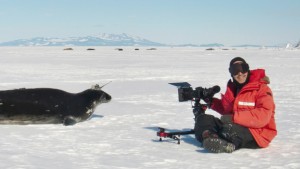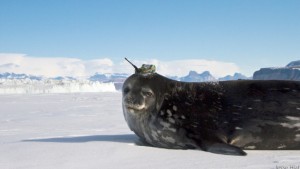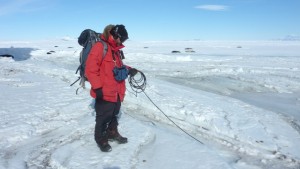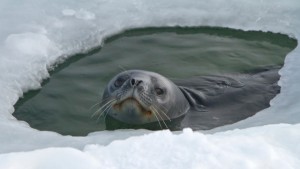Bay Area filmmaker and musician Jesse Hiatt traveled with UC Santa Cruz marine biologist Dan Costa to Antarctica in October 2011 and February 2012. Professor Costa had been awarded a National Science Foundation grant to study the winter foraging ecology of Weddell seals in Antarctica through the use of sophisticated satellite tags and physical examinations conducted by his research team. Hiatt first met Professor Costa while studying marine biology at UC Santa Cruz, where he developed 3D visualization software for diving mammals.
During the research trip, Hiatt spent long days filming Costa and other UC Santa Cruz researchers as they deployed and retrieved satellite tags from the seals and examined the large marine mammals. His breathtaking footage was edited into the two-minute QUEST segment, "Field Notes: Dan Costa in Antarctica." In June 2012, QUEST Producer Sheraz Sadiq conducted an interview via email with Jesse Hiatt about his unforgettable experience working in Antarctica and getting up close to the hardy seals during their breeding season. The following is an excerpt of the interview which has been edited for length and clarity.

Can you describe the gear that you used while filming in the harsh, extreme climate of Antarctica?
I decided to use a Canon 7D for this project, because it is a fairly rugged weatherized camera. More importantly, I realized that despite the challenges of using a DSLR camera for video, it allowed me to stay within my budget and it could deliver the most high-quality cinematic footage. It would also take good stills. To make the camera more suitable for shooting video, I had a Zacuto EVF external viewfinder, a matte box with a variable ND filter and a Zacuto follow focus unit.
Traveling in Antarctica can be a real challenge. We traveled by foot, snowmobile (referred to in Antarctica as snow-machines) and helicopter. Space was always limited and in every case I could not take nearly as much equipment as I would have liked. There was no one system that worked for all occasions. I had a bewildering array of different cases, backpacks and bags and would have to decide each day what I would bring and how to pack it. And every time, as Murphy's Law would suggest, there would be a great opportunities to use whatever I left behind.

We had a small box on the back of the snow-machine for gear and that would get seriously battered and beaten. I had several pieces of gear broken this way, and found the only safe place for cameras and lenses was in my backpack. When traveling by helicopter, space was even more limited, and I resorted to wrapping my Sachtler tripod in bubble wrap (no room for the case) and holding my camera in my lap.

